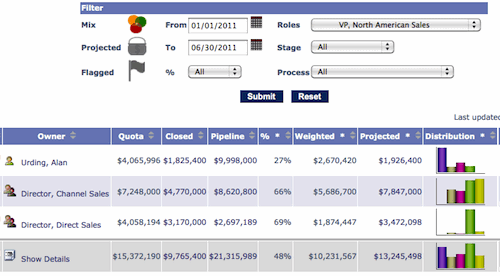Getting the sales forecast right is an ongoing battle for most sales professionals. Getting it wrong is very expensive, and often contributes to the short tenure of sales managers. As I’ve written before, sales people spend 2 ½ hours per week, on average, working on their sales forecast, massaging the numbers, before they submit their committed number to their managers, who in turn apply their own interpretation, before passing their forecast up the chain. There are lots of wasted cycles, and many contributory factors to this unproductive exercise.
Most CRM systems fail to provide an accurate sales forecast. This is partly due to incomplete or inaccurate data entered by the users. In my opinion, though, the larger culprit is the approach taken by most CRM systems – and one great example of that is the ‘weighted forecast’, or ‘weighted pipeline value’. (In some CRM systems this is referred to as ‘Expected Revenue’, which, in my opinion, is even more of a misnomer.)
I think you know what I mean. This is where you take the total value of the pipeline, and multiply it by the average probability – in % terms – of closure to come up with a weighted pipeline value. I think this number is entirely without value – but I’d like your perspective.
I asked my Twitter (@sales20network) followers about this last week, and their views seem to echo my opinion:
Is a weighted pipeline or sales forecast of any value?
- “No. Boss: I see you have a 500k prospect @50%. That’s great then I will put you down for 250k on that one and put it in my report to the board. Salesperson: Ehhhhhhhhhhh no. I might not win deal so that might be a Zero as much as it might be 500k.”
- “I give it about a 50%…”
- “Weighted pipelines can have the adverse effect of driving managers to adjust probabilities on everything in the pipeline”
- “No! it should be interpreted together with historical pipe conversion rate and distribution of the sales stages of opportunities.”
Everyone used to use Weighted values in the past, so when we first developed Dealmaker, we included the weighted pipeline number in the forecast report – see above – and it has remained there ever since.
I think we are going to remove it now.
Let me explain this a little more.

–
I use Dealmaker everyday, and when looking at the sales forecast it generates, I never look at the Weighted number. Instead I make my business decision based on the Projected forecast. If you’re a Dealmaker user, you know that the Projected number is calculated by Dealmaker by looking at what specific progress has been made in a sales opportunity, how much time is left in the forecast period, and then deciding if (100% of) this deal is going to close. Because Dealmaker also calculates the probability of closure based on the salesperson’s activities, and the evidence of advancement from the customer, then this number is usually accurate.
In the example in the graphic, you can see that Alan Urding has a weighted pipeline % of 27%, and a corresponding weighted value. However, you never win 27% of a deal. You either get 100% or nothing. The Projected number here actually shows that the weighted number provides an overly optimistic view. However, for the Director, Channel Sales, you see that the weighted number actually undervalues the forecast.
When calculating the Projected number, Dealmaker does exactly what an experienced sales person or sales manager does; it goes through the opportunities and picks out the actual deals you are going to win.
So, are weighted values entirely without merit?
Should we remove it from the forecast report screen?
Let me know what you think.



